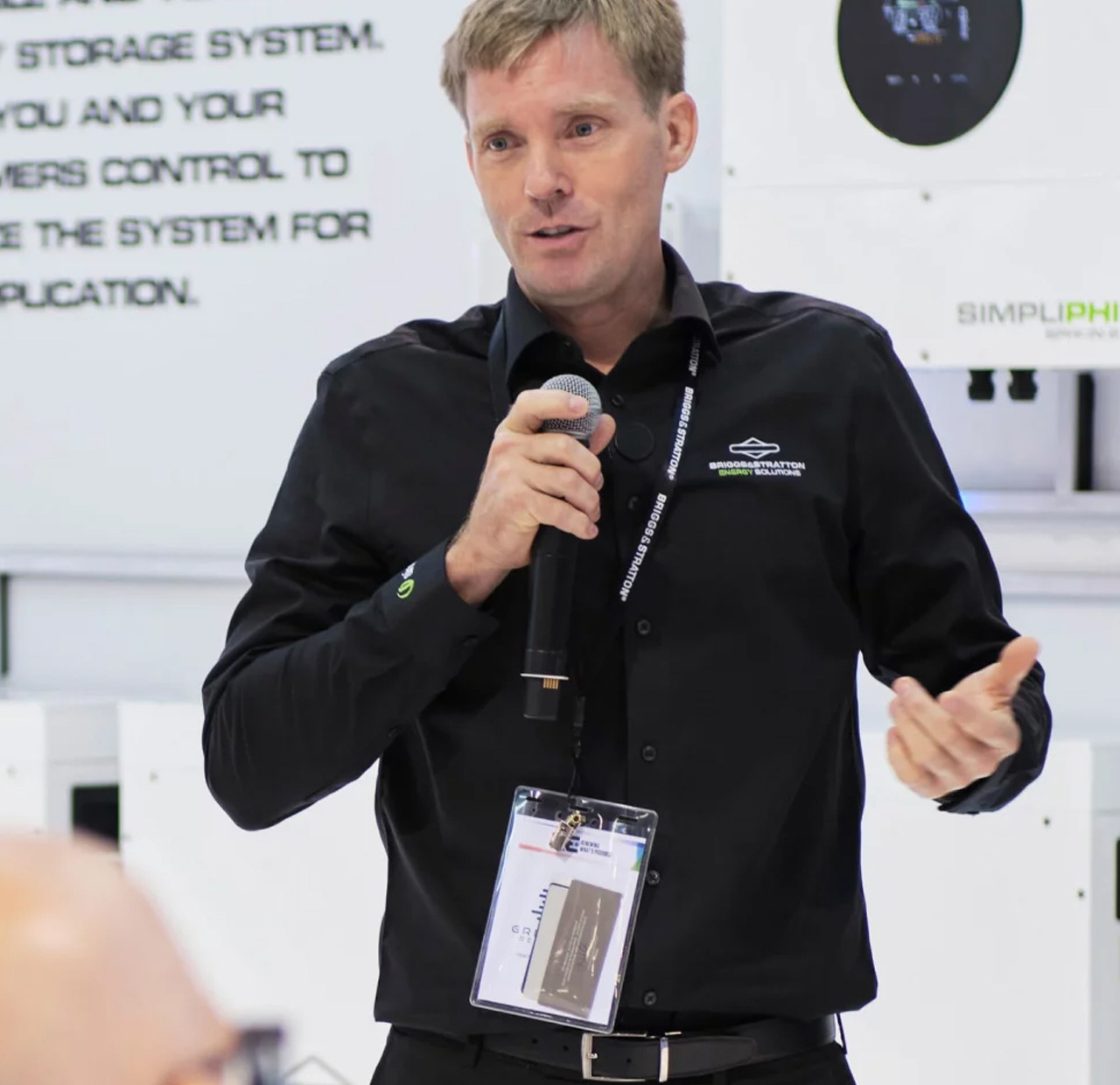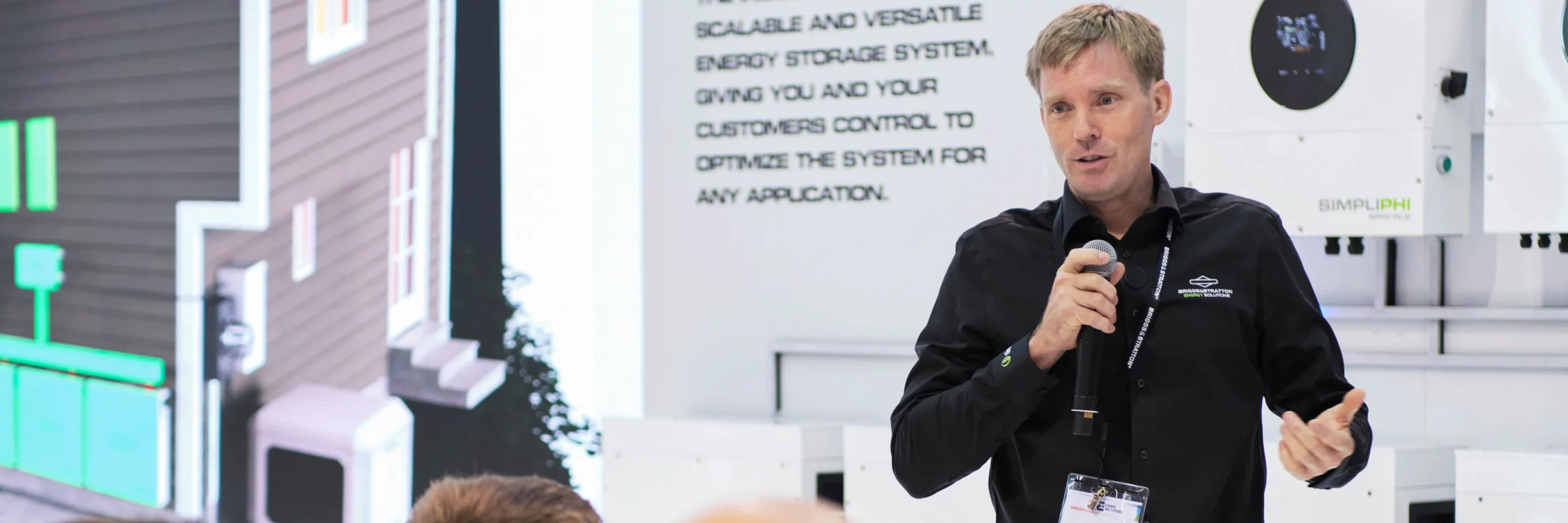Explore Our Partner Rebates Act Now to Secure Your Clean Energy Tax Credits


Elite IQ Installers
Take advantage of our in-person and virtual training
Building codes and standards are essential for ensuring that residential energy storage systems are safe, effective, and reliable. This course covers the National Fire Protection Association (NFPA) 855 Standard for the Installation of Stationary Energy Storage Systems (ESS). We specifically look at Chapter 15 of NFPA855 - ESS installations associated with residential dwellings and how it informs the International Residential Code (IRC), which many states adopt in their building codes. Learn about these ever evolving codes and standards while also having a chance to ask your questions of the experts at Briggs & Stratton Energy Solutions.
This free training will focus on topics including:
Learn about the latest battery technology coming from Briggs and Stratton. The SimpliPhi 6.65kWh battery modules can be assembled into 20kWh stacks in a matter of minutes. Improved technology offers both a broader temperature charging range and increased energy output. Learn about communications, connections, and commissioning options.
This free training will focus on topics including:
Whether you live off-grid by necessity or by choice, Briggs & Stratton's expertise in solar+storage+generator microgrid electrical systems ensures that you have all the power you need to cover 100 percent of your power requirements. Briggs & Stratton storage solutions are designed to work seamlessly with any source of power generation, including photovoltaics and propane/natural gas generators. Our modular and scalable storage can be sized to provide all the energy your lifestyle and home require today as well as into the future. Our safe and powerful LFP off-grid battery banks are trusted worldwide in electrified communities, rural and remote areas without utility service, as well as in natural disaster recovery zones.
This free training will focus on topics including:
ESS & Environmental Considerations (NABCEP Credit)This free webinar will inform installers and system owners about common issues related to extreme weather and environmental conditions that can impact performance and require maintenance and the strategies to mitigate these effects. Don’t miss this unique opportunity to engage with energy storage system design experts on the many strategies for ensuring customers have a reliable ESS system that will deliver cost savings and resilience for years, no matter the forecast. This training will include:
Participants in this training will earn 1.0 credit toward NABCEP certification and meet one of the requirements for Briggs & Stratton’s Elite IQ Installer Training Program. Click here for details on NABCEP credits. |
 |
With the new Net Energy Metering 3.0 (NEM 3.0) interconnection agreement now effective in California, the days of your customer's one-to-one offset credits for excess energy supplied to the utility grid are gone. As the value of the export rates under NEM 3.0 will be much lower, leveraging Energy Storage Systems (ESS) is going to be key in making grid-tied photovoltaic systems financially viable for system owners.
Don’t miss this opportunity to engage with energy storage system design experts on how a reliable and safe ESS system from Briggs & Stratton will deliver cost savings and resilience for years to come, no matter the interconnection agreement rules!
This training will cover:
The benefits, technical support, requirements and perks of Briggs & Stratton Elite IQ (Installer Qualification) Training Program – we’re here for you!
Utility outages – both planned and unplanned – are becoming more frequent and more costly due to our aging electric grid and natural gas infrastructure. The disastrous blackouts in Texas and throughout the Southern US are just some of the most recent examples.
Distributed, customer-sited energy storage systems are the most cost-effective way to build customer resilience for businesses and homeowners, and can be installed as standalone backup power solutions, or integrate with solar generation, or even with fuel-based generators to extend fuel reserves through days or weeks of a power outage. When conditions are normal and the grid is operational, these flexible energy storage systems also provide several economic benefits as well, from peak shaving to offsetting time of use (TOU) utility charges daily.
With Briggs & Stratton’s scalable UL-certified energy storage solutions, adding resilient backup power has never been easier! Join us as we discuss benefits, features, options, and frequently asked questions about maximizing, integrating and retrofitting energy storage for homes and businesses.
If you are an installer considering energy storage as an offering – then sign up today!
This training will cover:
Completion of the introductory Briggs & Stratton Elite IQ Installer Training (Battery Chemistry 101) is recommended, but not required.
The new SimpliPHI ESS presents great off-grid options with easy generator integration, cold weather solutions and flexible sizing. This training includes ESS topics specific to off-grid installations. Gain peace of mind with years of maintenance-free, safe, and efficient energy storage by replacing and upgrading your lead-acid system with high-performance PHI lithium ferro phosphate (LFP) batteries!
This free training will focus on topics including:
Completion of the introductory Briggs & Stratton Elite IQ Installer Training (Battery Chemistry 101) is recommended, but not required.
Battery Chemistry 101 (NABCEP Credit)With more power outages, extreme weather, and rising energy costs, demand for on- and off-grid customer-sited energy storage + solar is increasing. This training will include:
Participants in this training will earn 1.0 credit toward NABCEP certification and meet one of the requirements for Briggs & Stratton ’s Elite IQ Installer Training Program. Click here for details on NABCEP credits. |
 |
Join SimpliPhi Power as we break down many different considerations to be made about battery communications. From design, to installation, to performance and features, it is important to understand how different battery communications protocols differ and how a comms enabled battery stacks up to a traditional non-comms enabled battery. Make sure to join us to figure out which type of battery is the best fit for your unique project! Topics will include:
Completion of the introductory Briggs & Stratton Elite IQ Installer Training (Battery Chemistry 101) is recommended, but not required.
Why the Battery Management System (BMS) Matters & Understanding the Different BMS Functions in the PHI and AMPLIPHI Batteries (NABCEP Credit)A battery management system (BMS) is key to a lithium-ion battery’s operation and performance. Briggs & Stratton Energy Solutions understands that ‘one-size-fits-all’ does not optimize or meet a customer’s project objectives. Join us to discuss our different BMS models, their functional features, and how to choose the best solution for your project! This training will include:
Participants in this training will earn 1.5 credits toward NABCEP certification and meet one of our Elite IQ Installer Training Program requirements. Click here for details on NABCEP credits. |
 |
Briggs & Stratton is breaking down everything you need to know to optimize performance, longevity, and cost savings with your PHI batteries.
In this training we’ll cover:
Completion of the introductory Briggs & Stratton Elite IQ Installer Training (Battery Chemistry 101) is recommended, but not required.
Briggs & Stratton batteries are used in a wide range of applications and are particularly well suited for different mobile industries – powering food and coffee trucks on the go, as well as recreational vehicles, emergency response and military applications. If you are an installer looking to expand your business into new market segments, this webinar is for you!
Safer than other lithium-ion alternatives, with a much more robust performance profile and cycle life, our industry-leading lithium ferro phosphate (LFP) batteries provide a suite of benefits for customers looking for reliable, efficient and scalable energy storage solutions.
Join Briggs & Stratton’s experts as we discuss how to leverage Briggs’ batteries and their use in mobile applications.
In this training, we’ll cover:
Please join us to discuss DC wiring methods including:
Achieving True Safety in Energy Storage: UL 9540A Fire Testing (NABCEP Credit)Safety is a critical consideration in selecting a lithium-ion Energy Storage System (ESS) to provide truly secure and resilient power. Fire Departments and AHJs rely on UL 9540A Fire Safety Testing and UL 9540 Certification to determine safety and installation requirements for ESS during the permitting process. We will provide an overview of the different lithium-ion battery chemistries (LFP, NMC, NCA, LCO) and cell form factors (cylindrical, prismatic, pouch) being utilized by manufacturers in the market today, the relative risk profile associated with each, and present our UL 9540A Fire Safety Test data and our UL 9540 Certification. In this training, you will learn:
|
 |
Our industry-leading batteries & scalable UL 9540 integrated systems practically sell themselves! Learn how to communicate Briggs & Stratton’s value & advantages.
Briggs & Stratton manufactures safe, reliable, non-toxic lithium ferro phosphate batteries that save customers money, provide resilient backup power, and integrate seamlessly with renewables, both on and off-grid. Demonstrating to customers how Briggs’ products meet their different objectives, communicating the benefits, and crafting a compelling pitch will help you accelerate your sales and create many more satisfied customers.
This free installer training will cover:
Excited for your PHI battery installation, but want to make sure you’ve checked off all the requirements needed to make it seamless? Safety is paramount when designing and installing energy storage systems (ESS), and Briggs & Stratton is here to help!
Topics covered in this free training will include:
Completion of the introductory Briggs & Stratton Elite IQ Installer Training (Battery Chemistry 101) is recommended, but not required.
Charge, Discharge and State of Charge (NABCEP Credit)Increase your knowledge and gain valuable NABCEP credits by joining our experts for a discussion that includes:
Participants in this training will earn 1.0 credits toward NABCEP and meet one of our Elite IQ Installer Training Program requirements. Click here for details on NABCEP credits. |
 |
This webinar explores the fundamentals of using batteries to maximize the production and use of energy from solar installations.
This training will include:
This webinar provides a comprehensive overview of the complete Briggs & Stratton Energy Solutions SimpliPHI™ Energy Storage System (ESS), including detailed information on various configurations with batteries, power sources, sizing, and other related aspects. This talk will show simple designs that provide a customer with the energy their home needs and allow homeowners to utilize solar, generators or batteries to augment grid power by choosing from basic energy backup packages.
This training will include:
This webinar explores the fundamentals of combining a generator and battery energy storage together to create more resilient systems.
This training will include:
Leveraging Communications in Energy Storage Systems with Sol-Ark and SimpliPHILearn about the advantages of utilizing closed loop communications with battery energy storage systems. This training will discuss how closed loop communications should be made and how the BMS communication between the battery and the inverter can help improve performance and system longevity. This free training will focus on topics including:
|
 |
Home battery backup is trending towards whole-home battery backup in which utility power passes through hybrid inverters. In such configurations solar energy and stored battery energy can be used to supplement or even virtually eliminate purchase of grid electricity. Such a configuration can maximize return on investment by self-consuming energy production. Learn how a Sol-Ark 15k paired with SimpliPHI batteries with their 15-year warranty is the ultimate ESS for whole-home backup. This training will explore installation options, wiring, and programming options for optimization.
This free training will focus on topics including:
AC & DC Coupling of a PV System with PHI Batteries (NABCEP Credit)This webinar provides an overview of AC and DC Coupling of a PV installation and how our PHI batteries can optimize your system. This training will include:
Participants in this training will earn 1.0 credit toward NABCEP certification and meet one of the requirements for Briggs & Stratton’s Elite IQ Installer Training Program. Click here for details on NABCEP credits. |
 |
Home battery installations are trending towards whole-home battery backup. Whole-home battery systems are now accounting for half of all home battery installations. Advances with larger inverters, such as the Sol-Ark 15k with 200A passthrough have simplified the installation process. Learn how a Sol-Ark 15k paired with Briggs and Stratton’s stackable SimpliPHI 6.6 batteries is the ultimate ESS for whole-home backup. This training will explore installation, wiring, and programming options to customize installation to fit customer needs.
This free training includes the following key topics:
Briggs & Stratton’s industry leading SimpliPHI batteries combined with Sol-Ark’s all-in-one hybrid inverters offer reliable backup power that can easily be customized to fit in a variety of applications. This training course will teach how to establish initial closed-loop communication pairing of the batteries to the inverter. The training will then use a variety of example systems to demonstrate programming to meet customer needs.
These include programming:
Join us for "Mastering Energy Storage Sales: Strategies for Success," where we'll dive into the topic of having a clear process for quoting and selling battery storage. This session is designed for energy storage sales professionals looking to navigate the unique landscape of selling and quoting energy storage systems. The need for energy storage is rapidly growing.
We’ll cover key topics such as taking a consultative approach to better understand customer needs, the benefits of energy storage, and why providing customers with multiple options is the most effective way to close a sale. Our training team will provide strategies to overcome common objections, leverage market trends, and position energy storage as a crucial component to providing peace of mind. This webinar will equip you with the knowledge and tools to close more deals and grow your business.
Key Takeaways:
Join us for an insightful webinar where we explore and demonstrate how to effectively use OpenSolar to design a proposal featuring Briggs & Stratton’s SimpliPHI batteries. The demand for reliable energy storage solutions continues to grow and generating accurate, professional proposals is key to closing sales. In this session, we’ll demonstrate how OpenSolar’s powerful features can streamline the sales process of Briggs & Stratton battery storage products.
This webinar will cover:
The majority of existing solar arrays on residential properties do not provide power in the event of a utility outage. Adding battery backup to a home can not only deliver battery power in a grid down situation, it can also keep the solar array running. This webinar provides an overview of AC and DC coupling of solar installations and explains how to leverage batteries to optimize production, self consumption, backup power.
This training will include: